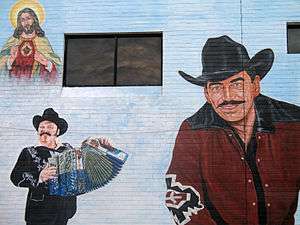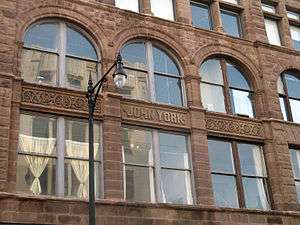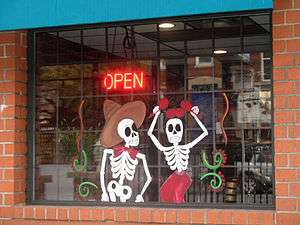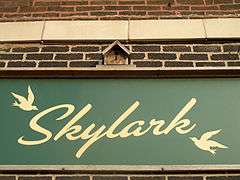Chicago/Pilsen
Only a few minutes from the center of Chicago by train, Pilsen is a working-class predominately Hispanic neighborhood. Marked by riches in art and historic architecture and occupied by a community that's fiercely proud of where they live, this neighborhood is at once distinctly Chicagoan and something entirely unique.
Understand

Pilsen was originally settled by Irish and German immigrants, who came to work at the factories and stockyards nearby. Those industries attracted Czech and Polish immigrants next, and in the late 1800s, the neighborhood was named in honor of the city back in the former's home in Bohemia. The streets of Pilsen still bear their mark — weathered stone castles like St. Adalbert's and Thalia Hall loom over buildings with colorful turrets and dashes of ornamentation completely absent of the Prairie School influence found elsewhere in Chicago. As Pilsen escaped relatively unscathed from the Great Chicago Fire in 1871, many of the buildings here are among the oldest in the city.
In the 1960s, the construction of the University of Illinois at Chicago displaced a community of Mexicans from the Near West Side, and many resettled in Pilsen. Meanwhile, many of the original Eastern European residents relocated to the suburbs due to government policies encouraging suburbanisation of the white population, while at the same time confining non-whites to the inner cities. Though they inherited an area in economic decline, Pilsen's new residents built a set of cultural institutions that far outpace many wealthier neighborhoods, crowned by the excellent National Museum of Mexican Art. And with the city's once-thriving West Side Italian community mostly wiped out by that same construction, a single block of the industrial Heart of Chicago neighborhood drew new focus as a place where Italian Chicago survived, remaining today as an alternative to the more heavily touristed Little Italy near the university.
Fears of gentrification began several years ago when the Podmajersky company began converting the old warehouses of East Pilsen into cheap studios for artists. Depending on who you ask, this was either intended to:
a) Revitalize the nearly vacant eastern half of an economically depressed neighborhood by creating spaces where exciting young artists could live, work, and exhibit, a "SoHo in Chicago";
b) Jump-start the process of gentrification that happened in Wicker Park several years earlier, driving up property values by exchanging low-income residents for wealthier ones looking to trade on that artistic "cool."
The artists arrived and opened galleries, but many left for lack of foot traffic. Most of those who remain have private studios, open to the public only for special events, giving East Pilsen the feeling of a ghost town on non-event days. There is an increasing split between the two halves of the neighborhood, and businesses seem torn between appealing to the working-class Mexican community already here and the affluent community that is still arriving. Whatever direction Pilsen may be headed, what's there now is an area with a long history of re-inventing itself, rough in places and full of inspiration, and guaranteed to provide visitors with an interesting day.

Get in
By train
Pilsen is very easy to reach by train from the Loop. The key is to know which part you'd like to visit first: the arts district in East Pilsen, which is centered at 18th and Halsted, and the arts/commercial center in West Pilsen, which surrounds 18th and Ashland. It's a long but manageable walk between the two areas, with a quiet zone in-between.
For East Pilsen, take the CTA Orange Line to Halsted, which is on the border of Bridgeport, and walk a few blocks north on Halsted (the street), crossing over the river almost immediately.
For West Pilsen, take the CTA Pink Line to 18th. (Even if you're just passing through, the astonishing murals at the 18th station are worth a look.) The Pink Line also stops in the Heart of Chicago neighborhood (Damen, Western) and then on to the Far West Side.
The last trains for both lines are around 1:15AM heading back toward the Loop (Downtown).
By bus
The streets of Pilsen don't get the same tender, loving care from snowplows as some other parts of the city, so the wind and the drifts can make walking between East and West Pilsen considerably more difficult.
- 8 Halsted runs the length of the arts district, coming from Bridgeport to the south and the Near West Side to the north. It connects with the Orange Line at the Halsted station.
- 9 Ashland will drop you at 18th and Ashland, near the taquerías and the Pink Line. It runs all night.
- 18 16th 18th runs, appropriately enough, down 18th street, connecting with the Pink Line at the 18th station.
- 49 Western runs down Western Avenue for nearly the full length of the city, passing near Pilsen and Heart of Chicago. It's an all-night route.
- 60 Blue Island/26th runs from the Chicago/Loop through the Near West Side, Pilsen, Little Village and South Lawndale all night long.
- N62 Archer branches off to cover the same ground as the 8 Halsted while passing through the arts district. The plain 62 Archer only stops within walking distance back at the Halsted Orange Line stop.
By car
If you're traveling within the city, the wide expanses of Western Avenue are the fastest way to reach Pilsen. Otherwise, use the I-55 exit at Damen Avenue for Pilsen, and the Canalport left exit off of I-90/94 to get to the arts district on Halsted.
See
Both halves of the neighborhood have annual open-doors festivals — see below.
West Pilsen
If you are walking down 18th Street from East Pilsen, it's around Racine that you'll begin to notice the change. Stores have cheerful skeletons in their windows, and inevitably some Spanish-language dance music is bumping off in the distance. By the time you reach 18th and Blue Island, take a break to enjoy the scene. Welcome to West Pilsen.
Quite a lot of artists have studios in West Pilsen, but few have regular open hours. Check at the cafes for information on exhibit openings.
- 🌍 A.P.O. Cultural Center, 1436 W 18th St (18th Pink Line), ☎ +1-773-780-1495. Hours vary. The enormous, foreboding stone edifice of the A.P.O. Building houses some worthwhile art exhibitions and the occasional concert along with community programs (such as the pool downstairs). Exhibits are usually free and open to all, but stern old ladies will keep you from wandering elsewhere.
- 🌍 CTA 18th Station, 1710 W 18th St (18th Pink Line). 4AM-1AM daily. Art and public transit have had a troubled relationship in Chicago, with awful results almost every time the CTA commissions a mural for a station. This one, however, is a gem. Local youth outreach efforts have borne fruit here, creating a walk from the station house to the platforms is nothing short of awe-inspiring (albeit distracting if you're in a hurry to catch a train). $2 to ride the train, free to view if getting off/back on a train.
- 🌍 National Museum of Mexican Art, 1852 W 19th St (18th Pink Line), ☎ +1-312-738-1503. Tu-Su 10AM-5PM. A lovely, small gallery full of vibrant colors and well-curated installations focused on understanding Mexican as well as Mexican-American history and culture through art. The museum serves as the center of the annual Day of the Dead celebration in the fall — this is a great time to visit to see all the brightly painted, skull-filled, and often humorous Ofrendas. Free.
- 🌍 Prospectus Art Gallery, 1210 W 18th St (18th Pink Line), ☎ +1 312-733-6132. Usually W-Sa noon-5PM. Fascinating exhibitions of traditional and contemporary Latin American art. It is a must-see when open, though it does close for long stretches between exhibits. Free.
- 🌍 St. Adalbert Church, 1650 W 17th St (18th Pink Line), ☎ +1-312-226-0340. Built in 1914 for the area's Polish community, St. Adalbert's still features murals of rousing crowd favorites like Queen Jadwiga's wedding and the time Our Lady of Częstochowa beat the hell out of some invading Swedes. It now includes a shrine in honor of Our Lady of San Juan de los Lagos and a few other touches for the Mexican Catholics who live in the neighborhood today.
- 🌍 St. Procopius Church, 1641 S Allport St (18th Pink Line), ☎ +1-312-226-7887. This towering stone church was built in 1883 for Czech Catholics in the area. Today, it's impressively weathered and gloomy from the street, but bright and austere if you manage a peek inside. Masses are held in English, Spanish, and Croatian.
- 🌍 Thalia Hall, 1807 S Allport St (18th Pink Line), ☎ +1-312-526-3851. This ornate former theater was built as a replica of an old opera house in Prague, and in its heyday served as the epicenter of Chicago Bohemian culture. Plays and operas were performed here, and much of the constitution of Czechoslovakia was drafted within these walls as well (at the end of World War I). Nearly a century later, after having served mainly as a residence for the local homeless, things seem to be looking up for Thalia Hall, with Dusek’s Board & Beer restaurant and Punch House bar now resident inside.
East Pilsen

Aside from old industrial atmosphere, there isn't much to see on an average day. The recession hit the East Pilsen art scene hard, and there are only a couple of small galleries that can be visited without an appointment. However, everyone opens up for browsing for the 2nd Fridays Art Walk (free, second Friday of each month, 6PM-10PM). The night often winds up at Skylark (see Bars).
The building at 1932 S Halsted has the highest concentration of studios, but you'll need to call up for access.
- 🌍 Chicago Arts District, 1821 South Halsted Street (Halsted Orange Line), ☎ +1-312-377-4444. This information center is located in the midst of things at 18th and Halsted, but it is generally only open to coincide with the 2nd Fridays Art Walk, so a stop to gather event cards at Kristoffer's Cafe (see Cafes) will be more informative on other days.
Do
- 🌍 Biblioteca Popular del Barrio, 1921 S Blue Island Ave (#60 CTA Bus or 18th Pink Line). Biblioteca Popular is an autonomous community operated library and art space. As well as providing access to underground, radical, and self-published literature, it is meant to be a safe space for the young and elderly, families, people of color, womyn, queer and trans folk, undocumented immigrants, and working class peoples. Donations accepted.
- 🌍 Harrison Park, 1824 S Wood St (18th Pink Line), ☎ +1 312-746-5491. If you have kids in tow and they have been patient through the National Museum of Mexican Art (or they need to burn off some energy before going in), you might reward them with some monkey time right next door at Harrison Park, which has a big play-lot with swings, slides, jungle gyms and more.
Events & Festivals
Don not forget the 2nd Fridays Art Walk every month in East Pilsen.
- 🌍 Mole de Mayo, 1800-1820 S Paulina (18th Street from Ashland to Loomis), ☎ +1 312-733-2287. 12AM-10PM F-Su a weekend in may. An annual mole cook-off and outdoor festival. Suggested donation $5 for individuals, $10 for families.
- 🌍 Chicage Art District, Halsted, around 18th and 19th (Halsted Orange Line), ☎ +1-312-738-0786. 2nd Fr Gallery nights. Studios in East Pilsen open their doors for an annual weekend-long festival. Even if the art does not resonate with you, it is worth visiting for the chance to explore the interesting physical spaces, from century-old sunken gardens to gargantuan old warehouses. free.
- 🌍 Pilsen Open Studios, 18th to Cermak, Leavitt to Carpenter (18th Pink Line), ☎ +1-312-733-6132. Second weekend of October. West Pilsen's studios open up for all to see. Local cafes and businesses get involved, and there's a free trolley on call for the route, too. A similar arts fest is often held in Little Village the same weekend.
- 🌍 Fiesta del Sol, 1000-1600 West Cermak Road, between Loomis and Morgan (18th Pink Line), ☎ +1-312-666-2663. late July or early August. Fiesta del Sol is an annual fundraising event organized by the Pilsen Neighbors Community Council that has been held annually since 1972. Over the years it has evolved from a block party into a nationally publicized event with corporate sponsorship, but the neighborhood's Hispanic community still has a strong presence. The three-day festival includes live entertainment, food, and vendor booths. Fiesta del Sol is alcohol and tobacco-free. $60, early bird $45.
Buy
Pilsen is an underrated shopping destination, with a few affordable and intriguing vintage stores on 18th. Also, the National Museum of Mexican Art has what may be the city's best museum gift shop.
- 🌍 Artesanias D'Mexico, 1644 W 18th St (18th Pink Line), ☎ +1 312-563-9779. Exceptional selection of handmade Mexican folk art and crafts, at prices that are nearly impossible to refuse. The friendly proprietors have lived in Pilsen for decades, and are a great source of information about the neighborhood and upcoming events.
- 🌍 Irv's Bike Shop, 1725 South Racine Avenue (18th Pink Line), ☎ +1-312-226-6330. M,Tu,Th,F 10AM-7PM, Sa 10AM-6PM. Pilsen is a serious bicycle neighborhood, and Irv's is a good place for repairs and accessories.
- 🌍 Knee Deep Vintage, 1425 W 18th St (18th Pink Line), ☎ +1-312-850-2510. M-Th 11AM-7PM, F-Sa 11AM-9PM, Su noon-6PM. Wide selection of vintage apparel spanning several decades for reasonable prices.
- 🌍 Ochoa Sporting Goods, 1749 West 18th Street (18th Pink Line), ☎ +1-312-829-9310. M-F 11AM-7PM, Sa 10AM-6PM, Su 10AM-3PM. There's Chicago-centric sports gear, too, but if you have a specific futbol jersey in mind, this is your best bet.
- 🌍 Sue Rosengard, 2210 South Halsted Street, ☎ +1 312 733-1133. W-F 11AM-6PM, Sa 10AM-5PM. Intriguing jewelry and ceramics a couple blocks south of the East Pilsen galleries, worth a browse even if you're not planning to buy anything.
Eat

Pilsen restaurants are gradually picking up variety — where once there were only taquerías and pizza joints, you'll now also find Chinese, Italian, and BBQ. But the taquerías remain the stars — authentic, cheap, and really good.
Equally memorable Italian restaurants can be found a little west in Heart of Chicago.
Budget
- 🌍 Carnitas Uruapan, 1725 W 18th Street (18th Pink Line), ☎ +1 312-226-2654. M-F 9AM-5PM, Sa-Su 7AM-6PM. The best carnitas (stewed pork) around. (Kids will love the cartoon pigs on the wall as long as they don't connect them to what they're eating.) The cactus salad comes highly recommended, too, but runs out early in the day. As for the rest of the menu, well, you either want a big sheet of fried pork rinds or you don't, and nothing this guide tells you is going to change your mind one way or the other. $6.
- 🌍 Panaderia Tortilleria Nuevo Leon Bakery, 1634 W 18th Street (18th Pink Line), ☎ +1-312-243-5977. M-F 5:30AM-9PM, Sa-Su 6AM-9PM. Tasty bakery run by the Nuevo León family, who run the fine restaurant a block down. They serve Mexican bread, pastries, coffee, and other early morning essentials under the watchful eye of a 1986-87 Chicago Bears team poster. $1-4.
- 🌍 Pizza Nova, 1842 W 18th St (18th Pink Line), ☎ +1-312-666-3500. Su-Th 11AM-midnight, F-Sa 11AM-1AM. Great stuffed pizza just across the park from the Museum of Mexican Art. $5-20.
- 🌍 Sabas Vega, 1808 S Ashland Ave (18th Pink Line), ☎ +1-312-666-5180. M-F 8AM-5PM, Sa-Su 6AM-5PM. Another good option for carnitas, with more seating than Uruapan. If it is cold outside, take note: they brag that their cauldron runs at 266 °F (130 °C)! $6.
- 🌍 Tacos Palacio, 1700 S Halsted St (Halsted Orange Line), ☎ +1-312-733-0433. 7AM-8:30PM daily. Perhaps the best taquería in Pilsen, so if you don't intend to have a sit-down multi-course meal, head straight here to grab some dirt cheap, incredible tacos. $2.50-9.
- 🌍 Taquería Los Comales #3, 1544 West 18th Street (18th Pink Line), ☎ +1-312-666-2251. Su-Th 7:30AM-1AM, F-Sa 7AM-3AM. A local chain that's almost certainly the quickest draw among Pilsen taquerías, with food made fresh and very fast, and served by a friendly waitstaff. $5-8.
- 🌍 The Jibarito Stop, 1646 W. 18th St (18th Pink Line), ☎ +1-312-988-0585, e-mail: info@thejibaritostop.com. Tu-F 11AM-8PM, Sa noon-8PM, Su noon-5PM. Puerto Rican joint serving jibaritos, a sandwich which uses slices of plantains instead of bread; a dish which originated with the Puerto Rican community in Chicago and cannot be found in Puerto Rico. $5-10.
Mid-range
- 🌍 De Colores, 1626 S Halsted St (18th Pink Line), ☎ +1 312-226-9886. Su-Th 11AM-10PM, F-Sa 11AM-midnight. Fresh, upscale Mexican cuisine (and desserts from Kristoffer's across the street) with an extensive gallery space. It is a great stop during the 2nd Fridays Art Walk. $10-15.
- 🌍 Honky Tonk BBQ, 1213 W 18th St (18th Pink Line), ☎ +1-312-226-7427. Tu-F 4PM-2AM, Sa 4PM-3AM, Su 4PM-2AM; kitchen closes at 11PM. Exactly what it sounds like — the speakers deliver honky tonk music, while the kitchen serves pulled pork sandwiches, beef briskets, rib tips, and cornbread. There's a full bar as well, with live music on Thursdays and weekends. $10-16.
- 🌍 Perez Restaurant, 1163 W 18th Street (Halsted Orange Line), ☎ +1-312-421-3631. M-Sa 6AM-8PM. Heaping plates of Mexican food and powerful margaritas, with outdoor seating when the weather permits. (Not to mention easy parking; hard to come by with other restaurants in the area.) Get the Lime (limon) Margarita. You won't regret it. $10-25.
Heart of Chicago
These are a bit out of the way but not hard to find, and if you like Italian food & ambiance, it's definitely worth the trip. Take the Pink Line to Western, walk a few blocks blocks south and then turn left to reach the 2400 South block of Oakley.
- 🌍 Bacchanalia, 2413 S Oakley (Western Pink Line), ☎ +1-773-254-6555. M-Th 11AM-10PM, F 11AM-11PM, Sa 4PM-11PM, Su 3:30PM-9PM. A warm, old world atmosphere and a busy kitchen. $14-22.
- 🌍 Bruna's Ristorante, 2424 S Oakley (Western Pink Line), ☎ +1-773-254-5550. M-Th 11AM-10PM, F-Sa 11AM-11PM, Su 1PM-10PM. Opened in 1933, and owned by an immigrant from Siena in Tuscany, who brings that influence to some of the dishes served here. $16-25.
- 🌍 Ignotz Ristorante, 2421 S Oakley (Western Pink Line), ☎ +1-773-579-0300. Tu-Th 11AM-10PM, F 11AM-11PM, Sa 4PM-11PM, Su 3PM-9PM. Thin-crust pizza, veal, and the straight-outta-The Sopranos exterior are the specials here. $7-24.
- 🌍 La Fontanella, 2414 S Oakley (Western Pink Line), ☎ +1-773-927-5249. M-F 11:30AM-10PM, Sa-Su noon-11PM. Since 1972. Dimly lit, with traditional Italian dishes and some creations of the chef. $18-28.
Drink
Pilsen is slowly building its nightlife options. Most of these options cater to local hipsters and artists in the area. Aside from the options listed here, a few of the restaurants listed above have bars worthy of your drinking dollar, Cuernavaca in particular. Otherwise, you might head over to the Near West Side on the 8 Halsted bus and booze it up there.
Cafes
- 🌍 Cafe Jumping Bean, 1439 W 18th St (18th Pink Line), ☎ +1 312-455-0019. M-F 6AM-10PM, Sa-Su 7AM-7PM. Reputation has it that this is Chicago's warmest and most inviting neighborhood coffee shop. It certainly lives up to the name: tiny, and always jumping with people. $2-6.
- 🌍 Cafe Mestizo, 1738 W 18th Street (18th Pink Line), ☎ +1 312-425-5724. 10AM-10PM daily. It's hard not to lose track of time at this welcoming, dimly-lit coffee shop. The walls are packed with work by local artists, and there's plenty of comfortable seating. Free Wi-Fi, too. $2-6.
- 🌍 Kristoffer's Cafe and Bakery, 1733 S Halsted St, ☎ +1 312-829-4150. M 7:30AM-3PM, Tu-F 7:30AM-5PM, Sa-Su 8AM-4PM. A warm, large space with a range of sandwiches, drinks, and baked goods. (They call their seven varieties of tres leches cakes a family specialty.) You will find free Wi-Fi and flyers for every art opening in the area. Lunch $5-8.
Bars

- 🌍 Simone's, 960 W 18th St (Halsted Orange Line), ☎ +1-312-666-8601. Su-F 11:30AM-2AM, Sa 11:30AM-3AM. Good food (especially the Mexican-influenced Pilsen Burger), but go for the beer: while their mixed drinks cost more than Skylark and aren't nearly as strong, they have an absolutely spectacular collection of beers on tap and in cans/bottles. That, and the decor is done out in this bizarre steampunk-pinball machine theme. They have good DJs spinning on most nights and trivia nights on Tuesdays.
- 🌍 Skylark, 2149 S Halsted St (Halsted Orange Line), ☎ +1-312-948-5275. Su-F 4PM-2AM, Sa 4PM-3AM. From the outside, it looks like an old-man bar that's been prepped for use as a bunker during World War II, but on the inside there's an excellent selection of cheap beer, pinball, a photobooth, some of the strongest $5 mixed drinks you'll find anywhere in the city, and tater tots — oh, delicious tater tots. If you have poor taste in movies, you might be delighted to hear that Skylark was featured prominently in the 2006 movie, The Breakup.
Sleep
Hotels in the Loop or Midway area are the best options for access here, a quick ride away on the CTA Orange Line.
Connect
Many of the local cafes offer internet access — see above.
- 🌍 Rudy Lozano Library, 1805 S Loomis St (18th Street Pink Line), ☎ +1-312-746-4329. M,W noon-8PM, Tu,Th 10AM-6PM, F-Sa 9AM-5PM. Free public internet access.
Stay safe
Smash-and-grab robberies have been reported for cars parked in East Pilsen during the 2nd Fridays art walk, so park in a well-lit area if possible and take any valuables with you (or, better, leave them at your hotel). Many Chicago residents overstate the crime rate in Pilsen, but it still has some problems. After dark, stick with other people and be aware of your surroundings.
Go next
- The majority of Chicago's Mexican-Americans live in Little Village to the west and near Marquette Park and Back of the Yards on the Southwest Side.
- The other major gallery scenes are in River North and the West Loop, albeit with far higher rents. You'll find a gallery scene even further off the beaten path in nearby Bridgeport.
| Routes through Pilsen |
| Cicero ← Far West Side ← | W |
→ Near West Side → The Loop |